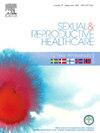Maternity care providers’ attitudes and beliefs toward weight and body size during pregnancy: A cross-sectional survey
IF 1.7
3区 医学
Q3 PUBLIC, ENVIRONMENTAL & OCCUPATIONAL HEALTH
引用次数: 0
Abstract
Background
Weight stigma is pervasive in society and negatively affects the quality of maternity care for women with larger bodies. Healthcare providers’ attitudes and beliefs about weight and larger bodied people contribute to experiences of weight stigma, yet the extent of weight stigma attitudes and beliefs in Australian maternity care providers is not known.
Objective
This study aimed to explore maternity care providers’ attitudes and beliefs regarding weight and body size during pregnancy.
Methods
A cross-sectional survey with Australian maternity care providers, using the Fat Attitudes Assessment Toolkit (FAAT), with an open-ended ‘any other comments’ text response, was undertaken. Quantitative responses were analysed using descriptive statistics and qualitative inductive content analysis.
Results
Maternity care providers (n = 243) from across Australia responded to the survey. Responses indicated a strong emphasis on empathy towards larger bodied pregnant women, with providers acknowledging the socioeconomic and societal impact on the complexity of weight and body size. Responses also highlighted providers’ internalised weight stigma. Free-text responses reflected mixed views on the balance between addressing health risks and avoiding weight stigma, with a need for more resources and education on weight-inclusive care.
Conclusion
Maternity care providers are aware of the complexities of caring for larger bodied women. Tailored interventions that promote empathy and reduce weight-based discrimination are recommended.
产科护理人员对孕期体重和体型的态度和信念:一项横断面调查
社会上普遍存在对体重的耻辱感,这对体型较大的女性的产科护理质量产生了负面影响。医疗保健提供者对体重和体型较大的人的态度和信念有助于体重耻辱的经历,但澳大利亚产妇保健提供者的体重耻辱态度和信念的程度尚不清楚。目的探讨产科护理人员对孕期体重和体型的态度和信念。方法采用“肥胖态度评估工具包”(FAAT)对澳大利亚产科护理提供者进行横断面调查,并采用开放式的“任何其他评论”文本回复。定量分析采用描述性统计和定性归纳内容分析。结果来自澳大利亚各地的产妇护理提供者(n = 243)对调查做出了回应。回应表明,医生们强烈强调对体型较大的孕妇的同情,并承认体重和体型的复杂性对社会经济和社会的影响。回应还强调了医疗服务提供者对体重的内在偏见。自由文本答复反映了对解决健康风险和避免体重污名之间的平衡的不同看法,需要更多的资源和关于体重包容性护理的教育。结论产科护理人员意识到照顾体型较大的妇女的复杂性。建议采取量身定制的干预措施,促进同理心,减少基于体重的歧视。
本文章由计算机程序翻译,如有差异,请以英文原文为准。
求助全文
约1分钟内获得全文
求助全文
来源期刊

Sexual & Reproductive Healthcare
PUBLIC, ENVIRONMENTAL & OCCUPATIONAL HEALTH-
CiteScore
2.70
自引率
5.60%
发文量
73
审稿时长
45 days
 求助内容:
求助内容: 应助结果提醒方式:
应助结果提醒方式:


